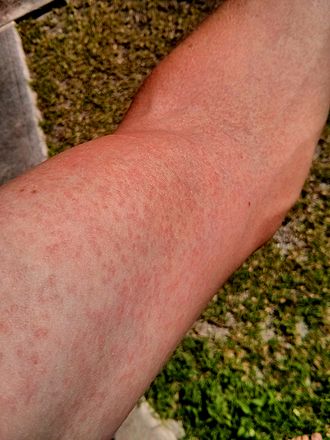Zika virus: Difference between revisions
No edit summary |
|||
| Line 1: | Line 1: | ||
__NOTOC__ | __NOTOC__ | ||
{{Zika virus}} | |||
{{About0|Zika virus infection}} | {{About0|Zika virus infection}} | ||
{{CMG}}; {{AE}} {{NRM}} | {{CMG}}; {{AE}} {{NRM}} | ||
Revision as of 18:08, 17 December 2015
|
Zika virus infection Microchapters |
|
Diagnosis |
|
Treatment |
|
Case Studies |
|
Zika virus On the Web |
|
American Roentgen Ray Society Images of Zika virus |
Editor-In-Chief: C. Michael Gibson, M.S., M.D. [1]; Associate Editor(s)-in-Chief: Nate Michalak, B.A.
| Zika virus | ||||||||
|---|---|---|---|---|---|---|---|---|
 rash on arm due to Zika virus
| ||||||||
| Virus classification | ||||||||
|
Organism
- Zika virus, also known as ZIKV, is an enveloped, icosahedral virus with a single-stranded, positive sense RNA genome. The most closely related virus is the Spondweni virus and is one of the two viruses in the Spondweni virus clade.[1]
- The ZIKV genome consists of 10,794 nucleotides that encode 3,419 amino acids[2]
- ZIKV is a member of the Flaviviridae family and of the flavivirus genus.
- There are two lineages for ZIKV: African and Asian.[2]
Human Pathogen
Transmission of ZIKV to humans is believed to occur through infected mosquitoes. The following species have been identified as vectors for the virus:[3]
|
|
ZIKV has also been proven to be sexually transmitted between humans by Brian Foy, a biologist at Colorado State University, in 2009.[4] ZIKV has been detected in amniotic fluid which indicates that the virus can cross the placental barrier and possibly infect a fetus.[5] Mosquito-borne ZIKV is thought to initially replicate in dendritic cells near the site of inoculation before spreading to lymph nodes and then the bloodstream. ZIKV can be killed by potassium permanganate, ether, temperatures >60°C, but is not effectively neutralized by 10% ethanol.[2]
Virology
- The incubation period for ZIKV is approximately three to 12 days after the bite of an infected mosquito.
- Detection of ZIKV is primarily based on isolation of RNA from blood serum through PCR in acutely ill patients.[6] An ELISA has also been developed by the Centers for Disease Control and Prevention to detect IgM against ZIKV.[2]
- ZIKV has a short viraemic period such that the virus can be detected in serum 3-5 days after onset of symptoms. ZIKV can be detected in urine up to 10 days after onset of symptoms.[6]
Cause of Zika virus infection
Zika virus infection is caused by ZIKV.
Refererences
- ↑ FIELDS, B. N., KNIPE, D. M., & HOWLEY, P. M. (2007). Fields virology. Philadelphia, Wolters Kluwer Health/Lippincott Williams & Wilkins.
- ↑ 2.0 2.1 2.2 2.3 Hayes EB (2009). "Zika virus outside Africa". Emerg Infect Dis. 15 (9): 1347–50. doi:10.3201/eid1509.090442. PMC 2819875. PMID 19788800.
- ↑ Duffy, Mark R.; Chen, Tai-Ho; Hancock, W. Thane; Powers, Ann M.; Kool, Jacob L.; Lanciotti, Robert S.; Pretrick, Moses; Marfel, Maria; Holzbauer, Stacey; Dubray, Christine; Guillaumot, Laurent; Griggs, Anne; Bel, Martin; Lambert, Amy J.; Laven, Janeen; Kosoy, Olga; Panella, Amanda; Biggerstaff, Brad J.; Fischer, Marc; Hayes, Edward B. (2009). "Zika Virus Outbreak on Yap Island, Federated States of Micronesia". New England Journal of Medicine. 360 (24): 2536–2543. doi:10.1056/NEJMoa0805715. ISSN 0028-4793.
- ↑ Foy, B. D.; Kobylinski, K. C.; Foy, J. L. C.; Blitvich, B. J.; Travassos Da Rosa, A.; Haddow, A. D.; Lanciotti, R. S.; Tesh, R. B. (2011). "Probable Non–Vector-borne Transmission of Zika Virus, Colorado, USA". Emerging Infectious Diseases. 17 (5): 880–882. doi:10.3201/eid1705.101939. PMC 3321795. PMID 21529401.
- ↑ http://www.cdc.gov/zika/transmission/index.html CDC Transmission
- ↑ 6.0 6.1 http://ecdc.europa.eu/en/healthtopics/zika_virus_infection/factsheet-health-professionals/Pages/factsheet_health_professionals.aspx ECDC Zika virus infection factsheet